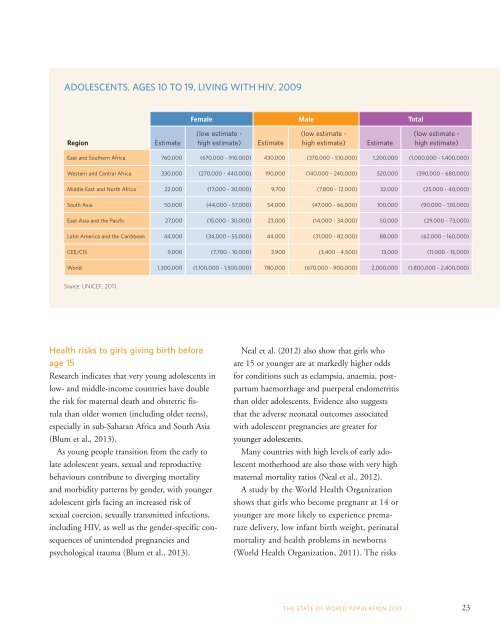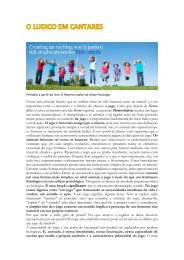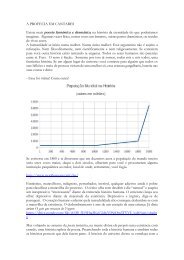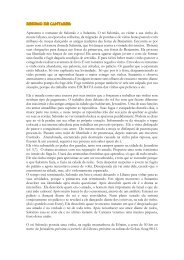Motherhood in Childhood
You also want an ePaper? Increase the reach of your titles
YUMPU automatically turns print PDFs into web optimized ePapers that Google loves.
ADOLESCENTS, AGES 10 TO 19, LIVING WITH HIV, 2009<br />
Female Male Total<br />
Region<br />
Estimate<br />
(low estimate -<br />
high estimate)<br />
Estimate<br />
(low estimate -<br />
high estimate)<br />
Estimate<br />
(low estimate -<br />
high estimate)<br />
East and Southern Africa 760,000 (670,000 - 910,000) 430,000 (370,000 - 510,000) 1,200,000 (1,000,000 - 1,400,000)<br />
Western and Central Africa 330,000 (270,000 - 440,000) 190,000 (140,000 - 240,000) 520,000 (390,000 - 680,000)<br />
Middle East and North Africa 22,000 (17,000 - 30,000) 9,700 (7,800 - 12,000) 32,000 (25,000 - 40,000)<br />
South Asia 50,000 (44,000 - 57,000) 54,000 (47,000 - 66,000) 100,000 (90,000 - 130,000)<br />
East Asia and the Pacific 27,000 (15,000 - 30,000) 23,000 (14,000 - 34,000) 50,000 (29,000 - 73,000)<br />
Lat<strong>in</strong> America and the Caribbean 44,000 (34,000 - 55,000) 44,000 (31,000 - 82,000) 88,000 (62,000 - 160,000)<br />
CEE/CIS 9,000 (7,700 - 10,000) 3,900 (3,400 - 4,500) 13,000 (11,000 - 15,000)<br />
World 1,300,000 (1,100,000 - 1,500,000) 780,000 (670,000 - 900,000) 2,000,000 (1,800,000 - 2,400,000)<br />
Source: UNICEF, 2011.<br />
Health risks to girls giv<strong>in</strong>g birth before<br />
age 15<br />
Research <strong>in</strong>dicates that very young adolescents <strong>in</strong><br />
low- and middle-<strong>in</strong>come countries have double<br />
the risk for maternal death and obstetric fistula<br />
than older women (<strong>in</strong>clud<strong>in</strong>g older teens),<br />
especially <strong>in</strong> sub-Saharan Africa and South Asia<br />
(Blum et al., 2013).<br />
As young people transition from the early to<br />
late adolescent years, sexual and reproductive<br />
behaviours contribute to diverg<strong>in</strong>g mortality<br />
and morbidity patterns by gender, with younger<br />
adolescent girls fac<strong>in</strong>g an <strong>in</strong>creased risk of<br />
sexual coercion, sexually transmitted <strong>in</strong>fections,<br />
<strong>in</strong>clud<strong>in</strong>g HIV, as well as the gender-specific consequences<br />
of un<strong>in</strong>tended pregnancies and<br />
psychological trauma (Blum et al., 2013).<br />
Neal et al. (2012) also show that girls who<br />
are 15 or younger are at markedly higher odds<br />
for conditions such as eclampsia, anaemia, postpartum<br />
haemorrhage and puerperal endometritis<br />
than older adolescents. Evidence also suggests<br />
that the adverse neonatal outcomes associated<br />
with adolescent pregnancies are greater for<br />
younger adolescents.<br />
Many countries with high levels of early adolescent<br />
motherhood are also those with very high<br />
maternal mortality ratios (Neal et al., 2012).<br />
A study by the World Health Organization<br />
shows that girls who become pregnant at 14 or<br />
younger are more likely to experience premature<br />
delivery, low <strong>in</strong>fant birth weight, per<strong>in</strong>atal<br />
mortality and health problems <strong>in</strong> newborns<br />
(World Health Organization, 2011). The risks<br />
THE STATE OF WORLD POPULATION 2013<br />
23

















